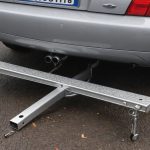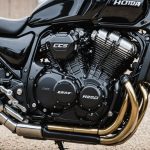Transform Your Kawasaki ZZR1400 with New Foot Pegs: A Comprehensive Guide
Upgrading the foot pegs on your Kawasaki ZZR1400 can be a game-changer for any serious motorcycle enthusiast. This simple yet effective modification can enhance your riding experience in multiple ways, from improved comfort and control to customized aesthetics. Here’s a detailed guide to help you through the process.
Why Upgrade Your Foot Pegs?
Before diving into the nitty-gritty of the upgrade process, it’s essential to understand why upgrading your foot pegs is worth the effort.
Also to see : Ultimate guide to tubeless tire puncture repair: step-by-step strategies for your ktm 790 adventure
Enhanced Comfort
Stock foot pegs on the Kawasaki ZZR1400 are designed to be versatile, but they may not offer the level of comfort you need for long rides. Upgraded foot pegs often feature cushioned surfaces and adjustable angles, providing tailored comfort that reduces rider fatigue significantly[1].
Improved Control and Stability
Performance-oriented foot pegs come with superior grip materials or serrated finishes that increase traction. This is particularly beneficial when navigating tight curves or riding in wet conditions, as improved foot placement and grip ensure a more secure and confident ride[1].
In parallel : Ultimate diy guide: transform your yamaha mt-07 with an aftermarket windscreen for superior wind protection
Customization Options
Upgrading your foot pegs also offers a fantastic way to express your personal style. With a wide array of designs, colors, and materials available, you can choose foot pegs that best suit your aesthetic preferences while complementing the overall look of your Kawasaki ZZR1400[1].
Choosing the Right Foot Pegs
Selecting the right foot pegs for your Kawasaki ZZR1400 involves considering several key factors.
Materials and Durability
Aluminum and titanium foot pegs are popular choices due to their lightweight and durable nature. These materials offer a balance between robustness and reduced motorcycle weight, making them ideal for performance and comfort[1].
Dimensions and Design
Aftermarket foot pegs are often wider than OEM pegs, typically measuring around 57mm in width. This larger platform spreads the load of impact over a larger part of the foot, making the peg easier to find and more comfortable to ride on. Additionally, longer pegs can provide more leverage for controlling the bike[2].
Grip and Traction
The grip of a foot peg is determined by the sharpness, number, or shape of the teeth. Some foot pegs feature threaded, replaceable cleats, while others have traditional teeth or arched and pivoting designs to keep more teeth in contact with the boot. Sharper teeth can provide better grip but may wear through boot soles quicker[2].
Step-by-Step Installation Guide
Upgrading your foot pegs is a DIY-friendly task if you have the right tools and follow the correct steps.
Gathering Essential Tools and Materials
Start by gathering essential tools such as an adjustable wrench, Allen keys, and a socket set. These tools will allow you to unscrew and secure various components of the foot pegs with precision. Ensure you have a service manual and all necessary hardware for the new foot pegs[1].
Preparing Your Workspace
Organize your workspace to ensure all necessary tools are within arm’s reach. Position the motorcycle securely on a center stand or a motorcycle jack to prevent accidental tipping. Evaluate the current foot peg condition to understand how to proceed with their removal[1].
Removing the Old Foot Pegs
Identify the mounting hardware used to secure the old foot pegs. Loosen the screws or bolts cautiously, holding the foot peg steadily to prevent it from falling. Inspect the removed components for wear or damage, as faulty parts can lead to stability issues[1].
Installing the New Foot Pegs
Align the new foot pegs with the designated mounting points. Use recommended hardware to secure them firmly, and confirm that bolts and screws are tightened adequately. Adjust the positioning of the foot pegs for comfortable riding, ensuring that your foot can rest naturally and securely during your rides[1].
Practical Tips and Considerations
Here are some practical tips and considerations to keep in mind during and after the installation process.
Signs of Improper Installation
Identifying signs of improper installation is crucial. If you notice unusual vibrations or instability while riding, it may indicate that the foot pegs aren’t securely attached. Proactively checking for loose bolts or misalignment can help prevent these problems[1].
Pro Tips for a Smooth Installation
Ensure you have the proper tools; a torque wrench can ensure bolts are tightened securely without excessive force. If misalignment persists, re-evaluate the peg placement. Sometimes, shimming might be required to achieve the correct alignment and stability[1].
Additional Features to Consider
When choosing new foot pegs, there are several additional features you might want to consider.
Pivot Protection
For riders who often find themselves in muddy or dirty conditions, pivot protection can be critical. Simple solutions like using a section of an old inner tube over the pivot point can help, but more advanced designs like those from Works Connection offer better protection[2].
Adjustable Height and Camber
Some foot pegs offer adjustable height options, which can lower your center of gravity and effectively raise the bars when standing. However, this can also cause the pegs to drag on the ground sooner. Adjustable camber features can help maintain grip on the pegs during turns by angling the top platform of the footpeg inward toward the bike[2].
Comparison of Popular Foot Peg Options
Here is a comparison table of some popular foot peg options for your Kawasaki ZZR1400:
| Foot Peg Model | Material | Width x Length | Special Features | Compatibility |
|---|---|---|---|---|
| Vanasche Motorsports 690/700/701 Adventure Footpegs | 7075 Aluminum Alloy | 2-3/8″ x 3-7/8″ | Oversized, adjustable height, lifetime warranty | KTM 690, Husqvarna 701, GasGas 700[4] |
| Talon Footpegs | Aluminum | 57mm wide | Threaded, replaceable cleats | Various motorcycle models[2] |
| Fastway Footpegs | Aluminum | 57mm wide | Adjustable height, replaceable platform | Various motorcycle models[2] |
| Pivot Pegz | Aluminum | 57mm wide | Pivoting platform, adjustable camber | Various motorcycle models[2] |
Real-Life Benefits and Testimonials
Upgrading your foot pegs is not just about theory; it has real-life benefits that many riders have experienced.
- Enhanced Comfort: “After upgrading my foot pegs, I noticed a significant reduction in rider fatigue during long rides. The cushioned surfaces and adjustable angles made a world of difference,” says John, a seasoned Kawasaki ZZR1400 rider.
- Improved Control: “The new foot pegs gave me much better grip and control, especially in wet conditions. It’s like having an extra layer of confidence when riding,” remarks Sarah, another enthusiast.
- Customized Aesthetics: “I chose foot pegs that matched my bike’s color scheme, and it completely transformed the look of my Kawasaki ZZR1400. It’s now a reflection of my personal style,” says Michael, a motorcycle customizer.
Upgrading the foot pegs on your Kawasaki ZZR1400 is a straightforward yet impactful way to enhance your riding experience. Whether you’re looking for improved comfort, better control, or a customized look, the right foot pegs can make all the difference.
By following the steps outlined in this guide, considering the various features and options available, and being mindful of practical tips and considerations, you can transform your ride into the best bike it can be. So why wait? Take the first step towards a more comfortable, controlled, and personalized ride with your new foot pegs.






